2014 AUDI TT ROADSTER child seat
[x] Cancel search: child seatPage 103 of 244
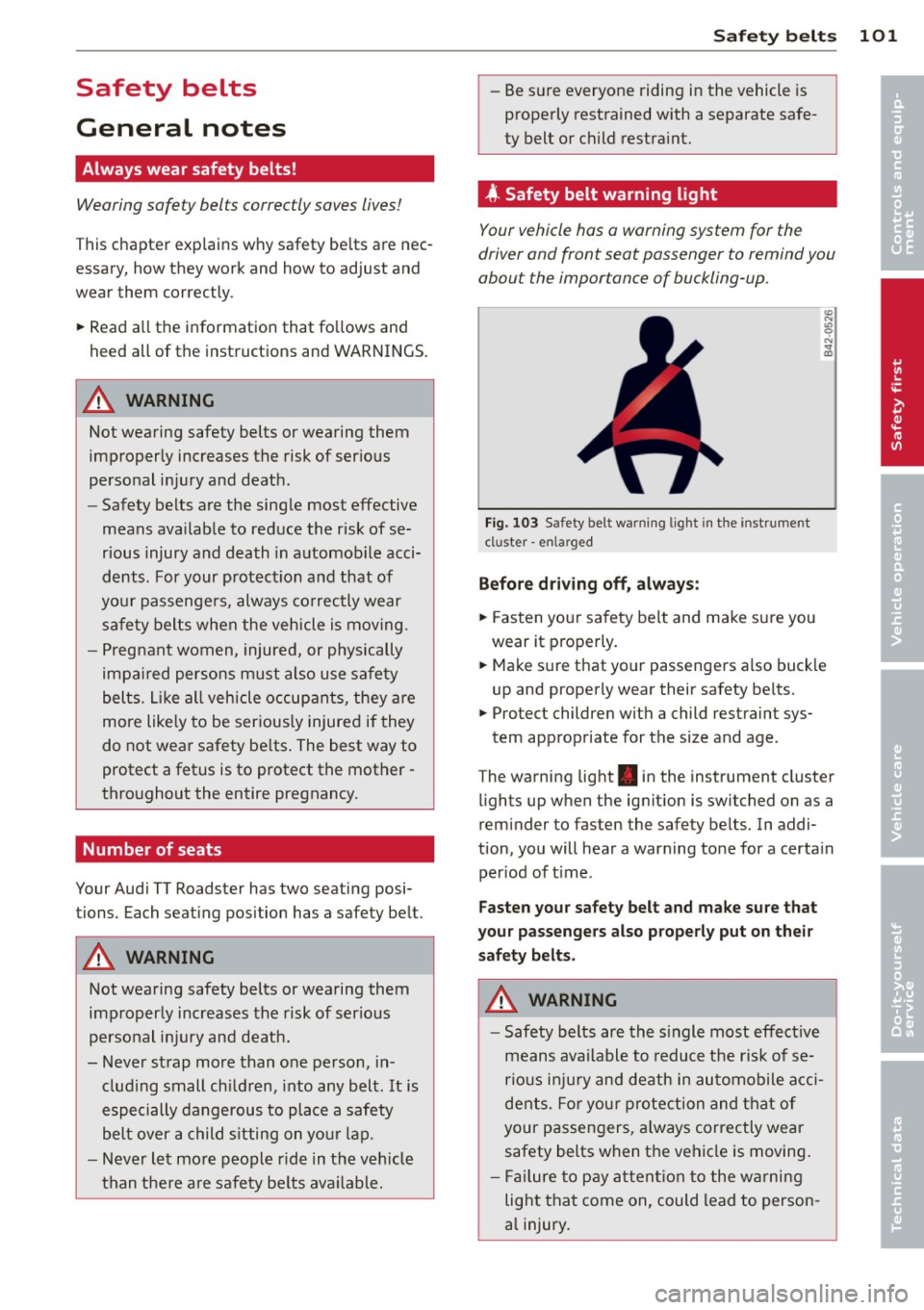
Safety belts
General notes
Always wear safety belts!
Wearing safety belts correctly saves lives!
This chapte r exp lains why safety be lts a re nec
essary, how they work and how to adjust and
wear them correctly.
~ Read a ll the informat ion that fo llows and
heed all of the inst ruct ions and WARNINGS.
A WARNING
Not wearing safety belts or wearing them
improperly increases the risk of ser ious
personal in jury and death .
- Safety belts are the sing le most effective
means availab le to red uce the r isk of se
rious injury and death in a utomob ile acci
de nts . For your prot ecti on and that of
yo ur passenge rs, always co rrec tly wear
sa fe ty bel ts when the ve hicle is mov ing.
- P re g nant women, injured, or physically
imp aired perso ns must also use safe ty
belts. L ike a ll vehicle occup ants, they are
more like ly to be ser ious ly injure d if they
do not wea r safety be lts . The best way to
protect a fet us is to protect the mother -
thro ughout the entire pregnancy.
Number of seats
Your Audi TT Roadster has two seating posi
tions. Each seat ing pos ition has a safety be lt.
A WARNING
Not wearing safety belts or wearing them
im proper ly increases the risk of ser ious
personal in jury and death.
- Never st rap more than one person, in
clu ding small ch ild ren, into any belt. It is
especially dangerous to place a safety
belt over a child s itting on yo ur lap.
- Never let mo re people ride in the ve hicle
t h an t he re a re safety be lts ava ilable.
Sa fety belts 1 O 1
- Be s ure everyone riding in the vehicle is
properly restrained w ith a separate sa fe
ty belt or child restra int.
4 Safety belt warning light
Your vehicle has a warning system for the
driver and front seat passenger to remind you
about the importance of buckling-up.
Fi g. 1 03 Safety be lt warn ing lig ht in the instr ume nt
cl uster -enla rged
Befor e driv ing off, always :
~ Fasten your sa fe ty belt and make su re you
wear it p roperly.
~ Make s ure that yo ur passenge rs a lso buck le
up and properly wear their safety be lts.
~ Protect childre n with a child rest raint sys-
tem appropriate for the s ize and age .
The wa rning light . in the instrument cluster
li ghts up w hen the ig nit ion is switched on as a
reminder to fasten the safety belts. In addi
tion , you will hear a warning tone for a certa in
per iod of t ime .
Fasten your safety belt and make sure that
your passengers also properly put on their saf ety belts .
A WARNING
-Safety belts are the s ingle most effect ive
means ava ilable to reduce t he risk of se
rio us inju ry and death in au tomobile a cci
de nts. Fo r yo ur pro tection and tha t of
your passen gers, a lways correctly wear
safety belts when t he ve hicl e is moving .
- Fail ure to p ay att ention t o the wa rni ng
light that come on, could lead to person
a l injury . •
•
Page 106 of 244
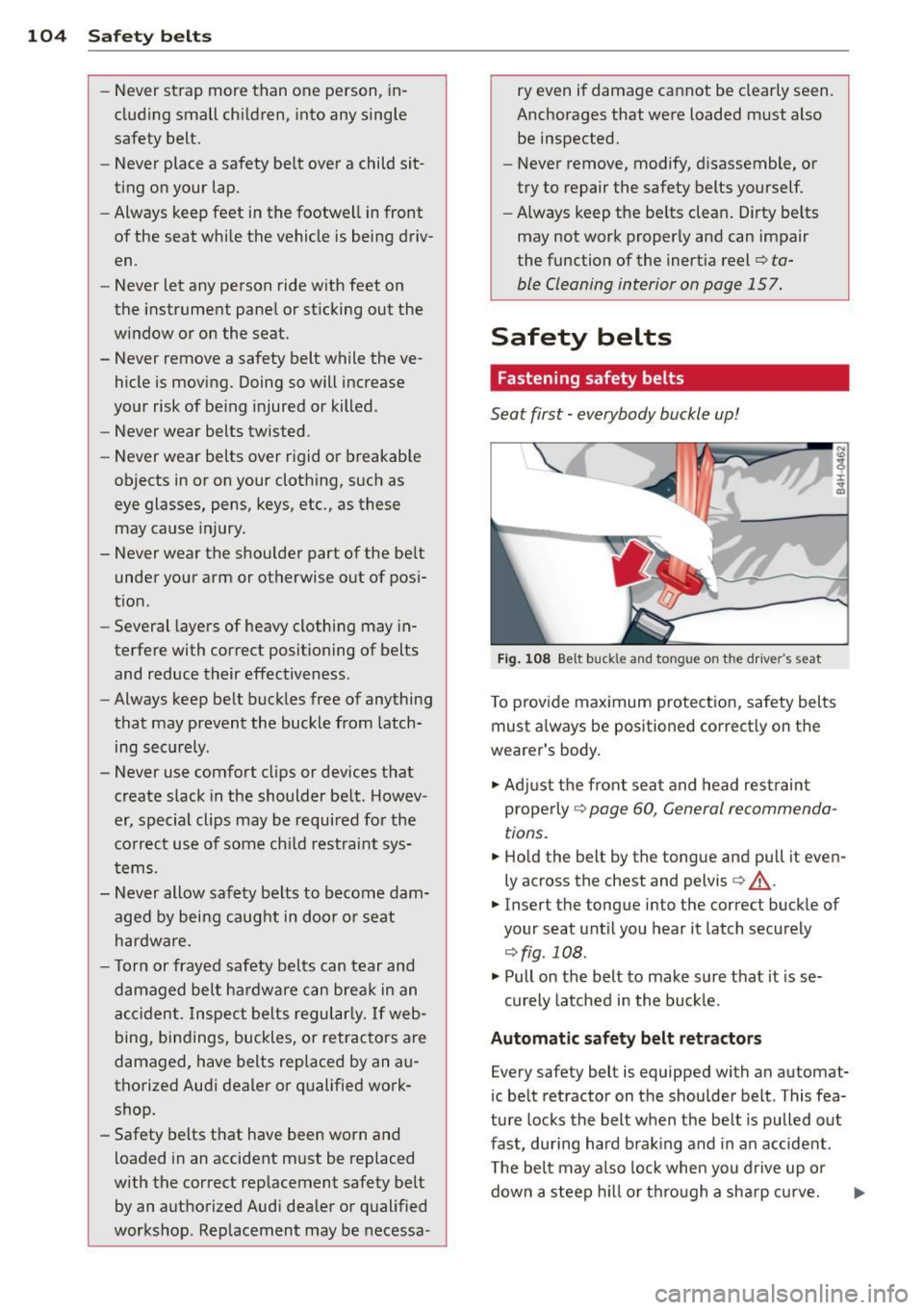
104 Safety belts
-Never strap more than one person, in
cluding small children, into any single
safety belt.
- Never place a safety belt over a child sit
t ing on your lap.
- Always keep feet in the footwell in front
of the seat while the vehicle is being driv
en.
- Never let any person ride with feet on
the instrument panel or sticking out the
window or on the seat.
- Never remove a safety belt while the ve
hicle is moving. Doing so will increase
your risk of being injured or killed.
- Never wear belts twisted.
- Never wear belts over rigid or breakable
objects in or on your clothing, such as
eye glasses, pens, keys, etc., as these
may cause injury.
- Never wear the shoulder part of the belt
under your arm or otherwise out of posi
tion.
- Several layers of heavy clothing may in
terfere with correct positioning of belts
and reduce their effectiveness.
- Always keep belt buckles free of anything
that may prevent the buckle from latch
ing securely.
- Never use comfort clips or devices that
create slack in the shoulder belt. Howev
er, special clips may be required for the
correct use of some child restraint sys
tems.
- Never allow safety belts to become dam
aged by being caught in door or seat hardware.
- Torn or frayed safety belts can tear and
damaged belt hardware can break in an
accident. Inspect belts regularly.
If web
bing, bindings, buckles, or retractors are
damaged, have belts replaced by an au
thorized Audi dealer or qualified work
shop.
- Safety belts that have been worn and
loaded in an accident must be replaced
with the correct replacement safety belt by an authorized Audi dealer or qualified
workshop . Replacement may be necessa- ry even if damage cannot be clearly seen.
Anchorages that were loaded must also
be inspected.
- Never remove, modify, disassemble, or
try to repair the safety belts yourself.
- Always keep the belts clean. Dirty belts
may not work properly and can impair
the function of the inertia reel¢
ta
ble Cleaning interior on page 157.
Safety belts
Fastening safety belts
Seat first -everybody buckle up!
Fig. 108 Belt buckle and tongue on the driver's seat
To provide maximum protection, safety belts
must always be positioned correctly on the
wearer's body.
.,. Adjust the front seat and head restraint
properly ¢
page 60, General recommenda
tions.
.,. Hold the belt by the tongue and pull it even
ly across the chest and pelvis ¢
.&_.
.,. Insert the tongue into the correct buckle of
your seat until you hear it latch securely
¢fig . 108.
.,. Pull on the belt to make sure that it is se-
curely latched in the buckle.
Automatic safety belt retractors
Every safety belt is equipped with an automat
ic belt retractor on the shoulder belt . This fea
ture locks the belt when the belt is pulled out
fast, during hard braking and in an accident .
The belt may also lock when you drive up or
down a steep hi ll or through a sharp curve.
Page 107 of 244
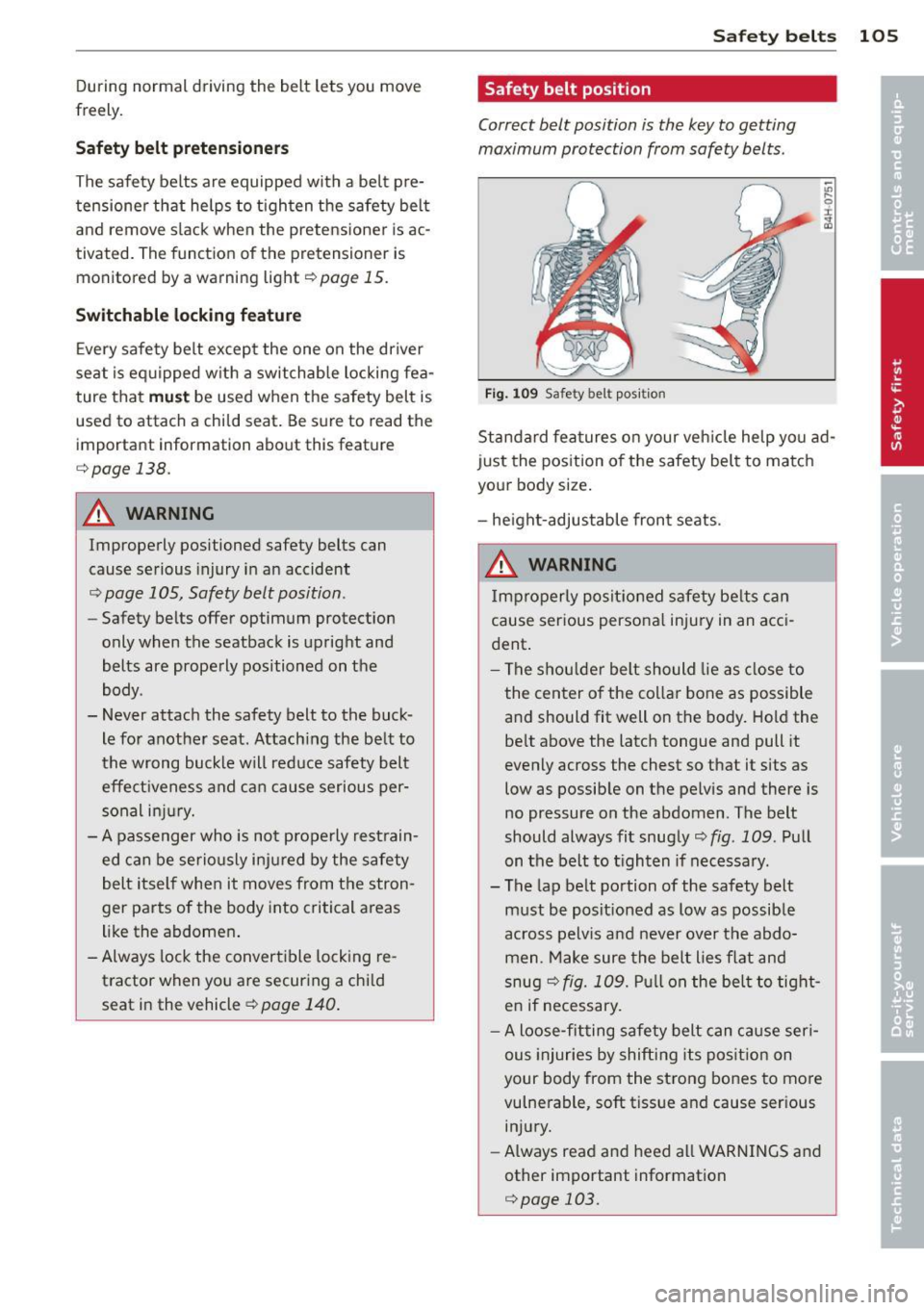
During normal driving the belt lets you move
freely.
Safety belt pretensioners
The safety belts are equipped with a belt p re
tensione r that helps to t igh ten the safety belt
and remove s lack when the pretensione r is ac
tivated. The function of the pretensioner is monitored by a warning light
q page 15.
Switchable lo cking feature
Every safe ty belt excep t the one on the driver
seat is eq uipped w ith a switchab le locking fea
ture that
mu st be used when the safety belt is
used to attach a child seat . Be s ure to read the
important informat ion about th is feature
q page 138.
A WARNING
Improperly positioned safety belts can
cause serious injury in an accident
¢ page 105, Safety belt position .
-Safety belts offer optimum protection
only when the seatback is upright and
belts are properly positioned on the
body .
-
- Never attach the safety belt to the buck
le for another seat . Attach ing the belt to
the wrong buckle will reduce safety belt
effect iveness and ca n cause serious per
sonal in jury.
- A passenger who is no t properly rest rain
ed can be serio usly inju red by the safety
belt itself when it moves from the stron-
ger parts of the body into critical areas
like the abdomen .
- Always lock the convert ible locking re
tractor when yo u are secur ing a chi ld
seat in the vehicle
¢ page 140.
Safety belts 105
Safety belt position
Correct belt position is the key to getting
maximum protection from safety belts .
Fig . 1 09 Safety belt po sit ion
;;;
9 r ., a,
Standard fea tures on your veh icle he lp you ad
just the position o f the safety bel t to matc h
your body size .
- he ight-adjustable fron t seats.
A WARNING
Improperly posit ioned s afety be lts c an
cause serious persona l injury in an acci
dent .
-
-The s hou lder belt should lie as close to
the center o f the collar bone as possible
a nd should fit well on the body. Hold the
be lt above the latch tongue and pull it
evenly across the chest so that it sits as
low as possib le on the pelv is and there is
no pressure on the abdomen . The belt
should always fit snugly¢
fig. 109 . Pull
on the belt to t ighten if necessary.
- The lap belt portion of the safety belt
must be posit ioned as low as possible
across pelvis and never over the abdo
men . Make sure the belt lies flat and
snug
q fig. 109. Pu ll on the be lt to tight
e n if necessary.
- A loose-fitting safety belt can cause seri
ous injuries by shifting its pos it ion on
your body from the strong bones to more
vulnerable, soft tissue and cause ser ious
injury.
- Always read and heed all WARNINGS and
other important information
¢ page 103.
Page 111 of 244
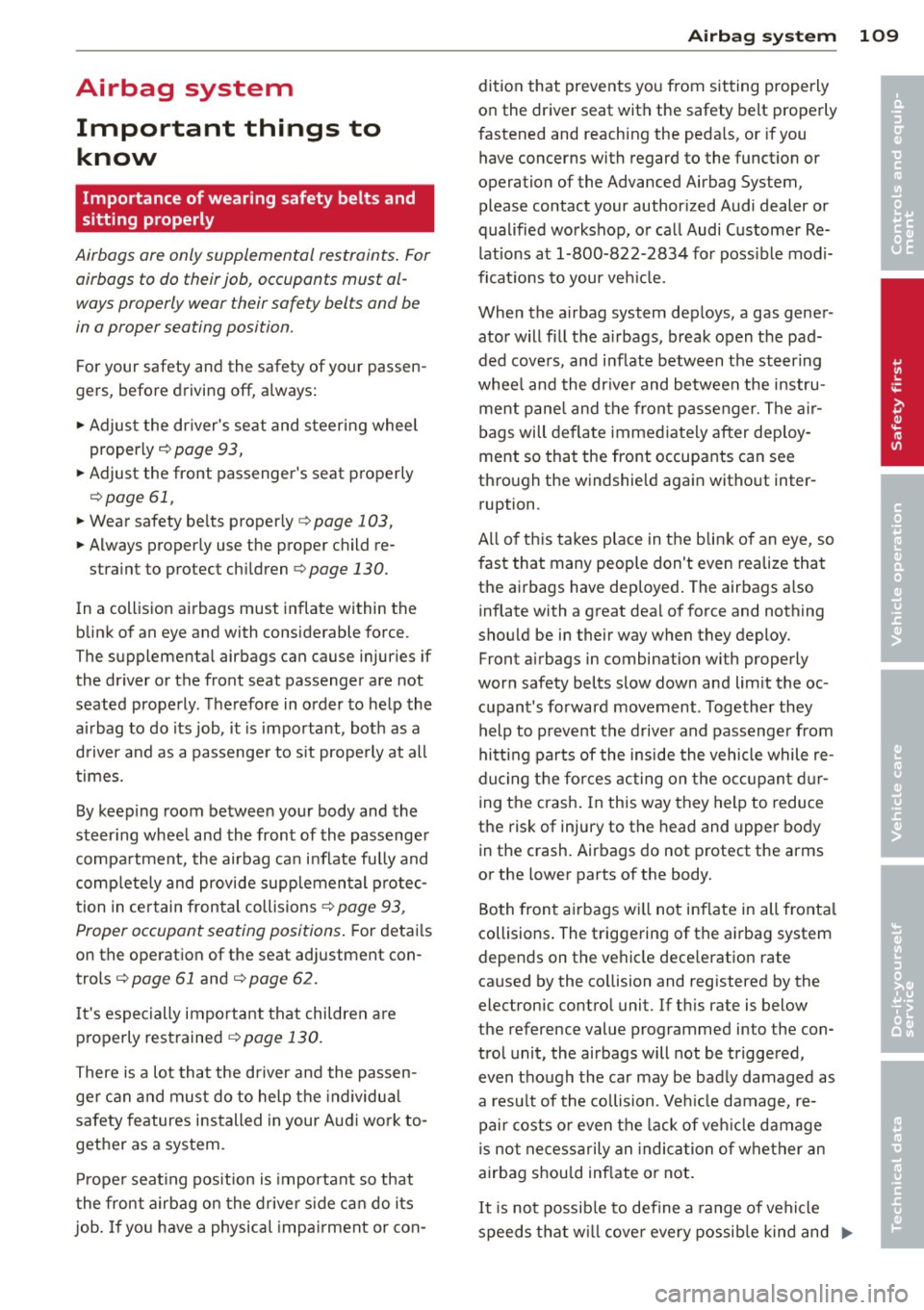
Airbag system Important things to know
Importance of wearing safety belts and
sitting properly
Airbags are only supplemental restraints. For
airbags to do their job, occupants must al
ways properly wear their safety belts and be
in a proper seating position.
For your safety and the safety of your passen
gers, before driving off, always:
"" Adjust the driver's seat and steering wheel
properly¢
page 93,
"" Adjust the front passenger's seat properly
¢page 61,
""Wear safety be lts properly ¢ page 103,
""Always properly use the proper child re-
straint to protect children
r::::> page 130.
In a collision airbags must inflate within the
blink of an eye and with considerable force.
The supplemental airbags can cause injuries if
the driver or the front seat passenger are not
seated properly . Therefore in order to help the
airbag to do its job, it is impo rtant, both as a
d river and as a passenger to s it properly at all
times.
By keeping room between your body and the
steer ing whee l and the front of the passenger
compartment, the airbag can inflate fully and
comp lete ly and provide supplemental protec
tion in certain frontal collisions
r::::> page 93,
Proper occupant seating positions.
F or details
on the operation of the seat adjustment con
trols ¢
page 61 and ¢ page 62.
It's especially important that children a re
properly restrained
r::::> page 130.
There is a lot that the driver and the passen
ger can and must do to help the individua l
safety features installed in your Aud i work to
gether as a system.
Proper seating pos ition is important so that
the front airbag on the driver side can do its
job. If you have a physical impairment or con-
Airbag system 109
dition that prevents you from sitting properly
on the driver seat with the safety belt properly
fastened and reach ing the pedals, or if you
have concerns with regard to the function or
operation of the Advanced Airbag System,
please contact your authorized Audi dealer or
qualified workshop, or call Audi Customer Re
lations at 1-800-822-2834 for poss ible modi
fications to your vehicle.
When the airbag system dep loys, a gas gener
ator will fill the a irbags, break open the pad
ded covers, and inflate between the steer ing
whee l and the driver and between the instru
ment panel and the front passenger. The air
bags will deflate immediately after deploy
ment so that the front occupants can see
through the windshield again without inter
ruption.
A ll of th is takes place in the blink of an eye, so
fast that many people don't even realize that
the airbags have deployed. The airbags a lso
inflate with a great dea l of force and nothing
should be in their way when they deploy.
Front airbags in combination with properly
worn safety belts slow down and lim it the oc
cupant's forward movement. Together they
help to prevent the driver and passenger from
hitt ing parts of the inside the vehicle while re
ducing the forces acting on the occupant dur
ing the crash . In this way they help to reduce
the risk of injury to the head and upper body
in the crash. Airbags do not protect the arms
or the lower parts of the body.
Both front airbags will not inflate in all fronta l
collisions . The triggering of the airbag system
depends on the vehicle dece leration rate
caused by the co llision and registered by the
electronic control unit. If th is rate is below
the reference value programmed into the con
trol unit, the airbags will not be triggered,
even though the car may be badly damaged as
a result of the collision . Vehicle damage, re
pair costs or even the lack of veh icle damage
is not necessarily an indication of whether an
airbag shou ld inf late or not .
It is not possible to define a range of vehicle
speeds that will cover every possible kind and ..,. •
•
Page 112 of 244
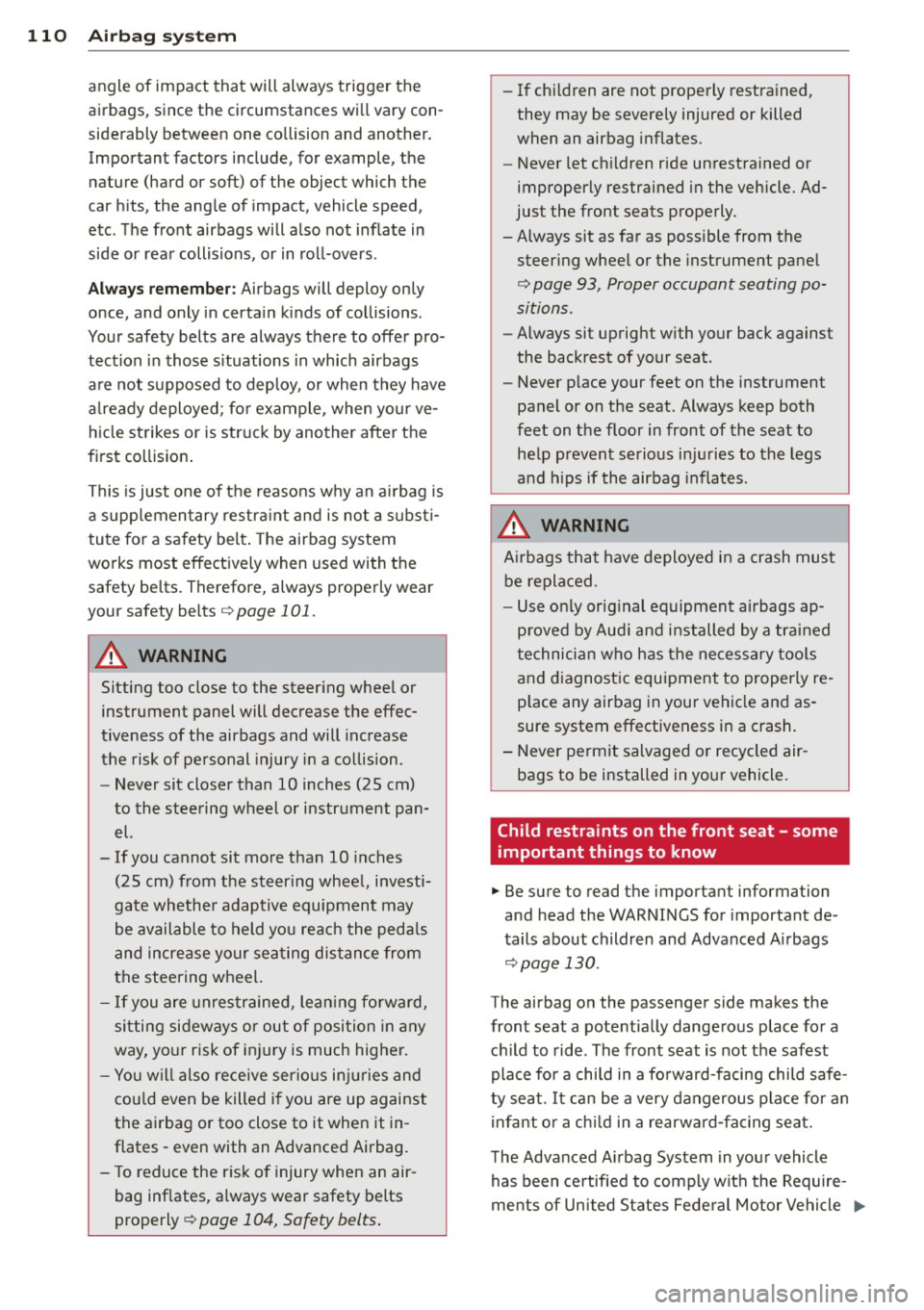
110 Airbag system
angle of impact that will always trigger the
airbags, since the circumstances will vary con
siderably between one collision and another.
Important factors include, for example, the
nature (hard or soft) of the object which the
car hits, the angle of impact, vehicle speed,
etc. The front airbags will also not inflate in
side or rear collisions, or in roll-overs.
Always remember: Airbags will deploy only
once, and only in certain kinds of collisions.
Your safety belts are always there to offer pro
tection in those situations in which airbags
are not supposed to deploy, or when they have
already deployed; for example, when your ve hicle strikes or is struck by another after the
first collision.
This is just one of the reasons why an airbag is
a supplementary restraint and is not a substi
tute for a safety belt. The airbag system
works most effectively when used with the
safety belts. Therefore, always properly wear
your safety belts¢
page 101.
A WARNING
Sitting too close to the steering wheel or
instrument panel will decrease the effec
tiveness of the airbags and will increase
the risk of personal injury in a collision .
- Never sit closer than 10 inches (25 cm)
to the steering wheel or instrument pan el.
- If you cannot sit more than 10 inches
(25 cm) from the steering wheel, investi
gate whether adaptive equipment may
be available to held you reach the pedals
and increase your seating distance from
the steering wheel.
- If you are unrestrained, leaning forward,
sitting sideways or out of position in any
way, your risk of injury is much higher.
- You will also receive serious injuries and
could even be killed if you are up against
the airbag or too close to it when it in
flates -even with an Advanced Airbag.
- To reduce the risk of injury when an air
bag inflates, always wear safety belts
properly
c::> page 104, Safety belts.
- If children are not properly restrained,
they may be severely injured or killed
when an airbag inflates.
- Never let children ride unrestrained or
improperly restrained in the vehicle. Ad
just the front seats properly.
- Always sit as far as possible from the steering wheel or the instrument panel
¢ page 93, Proper occupant seating po
sitions.
- Always sit upright with your back against
the backrest of your seat.
- Never place your feet on the instrument
panel or on the seat. Always keep both
feet on the floor in front of the seat to help prevent serious injuries to the legs
and hips if the airbag inflates.
A WARNING
Airbags that have deployed in a crash must
be replaced.
- Use only original equipment airbags ap
proved by Audi and installed by a trained
technician who has the necessary tools
and diagnostic equipment to properly re
place any airbag in your vehicle and as
sure system effectiveness in a crash.
- Never permit salvaged or recycled air bags to be installed in your vehicle.
Child restraints on the front seat - some
important things to know
.. Be sure to read the important information
and head the WARNINGS for important de
tails about children and Advanced Airbags
¢page 130.
The airbag on the passenger side makes the
front seat a potentially dangerous place for a
child to ride. The front seat is not the safest
place for a child in a forward-facing child safe
ty seat.
It can be a very dangerous place for an
infant or a child in a rearward-facing seat.
The Advanced Airbag System in your vehicle
has been certified to comply with the Require
ments of United States Federal Motor Vehicle .,.
Page 113 of 244
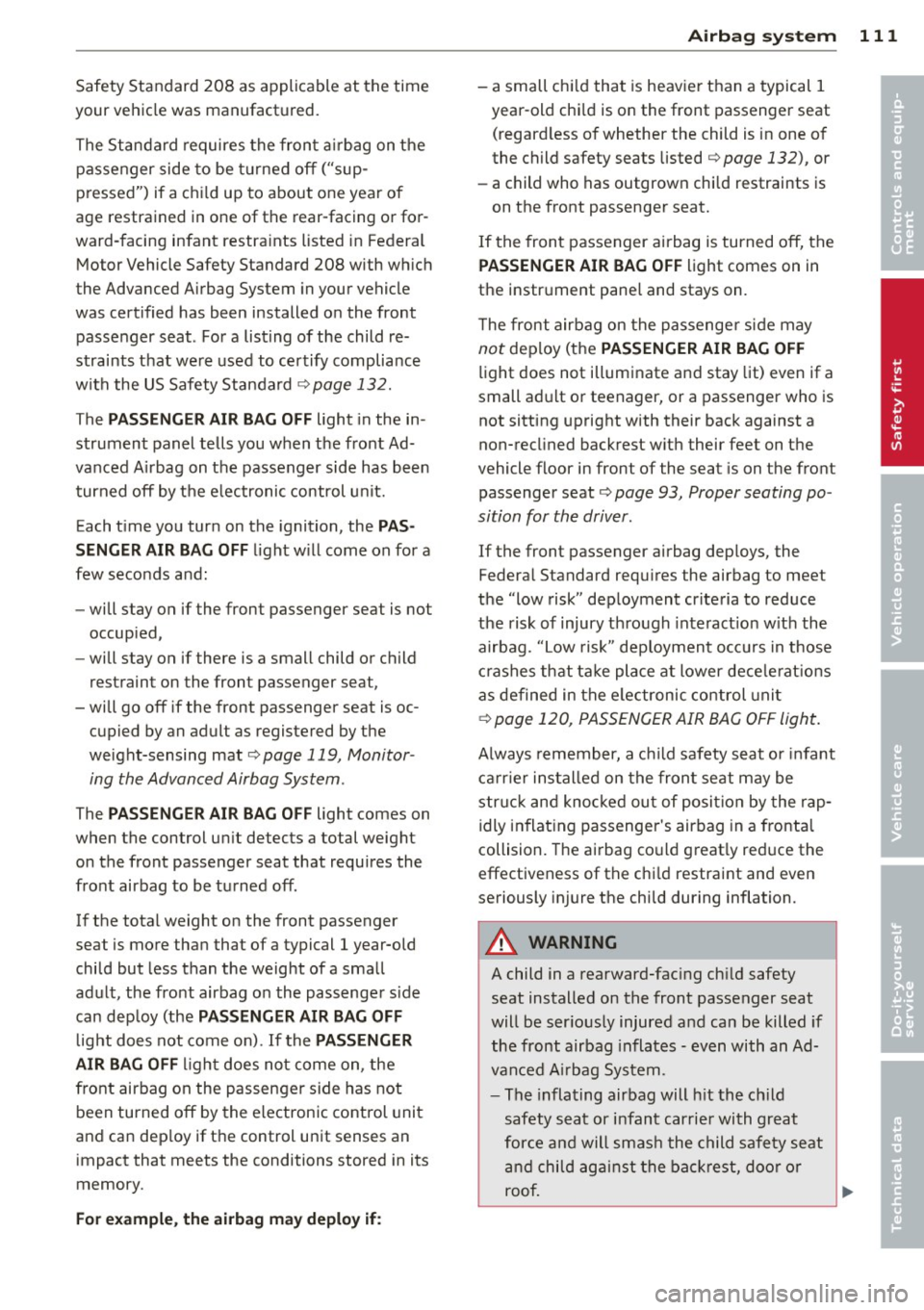
Safety Standard 208 as applicable at the time
your vehicle was manufactured.
The Standard requires the front a irbag on the
passenger side to be t urned off ("sup
pressed") if a child up to about one year of
age restrained in one of the rear -facing or for
ward -facing infant restra ints listed in Federal
Motor Vehicle Safety Standard 208 with wh ich
the Advanced Airbag System in your vehicle
was certified has been installed on the front passenger seat. Fo r a listing of the child re
straints that were used to certify compliance
with the US Safety Standard
¢ page 132.
The PAS SENG ER AIR BAG OFF light in the in
strument panel tells you when the front Ad
vanced A irbag on the passenger side has been
turned off by the e lectronic control u nit.
Each t ime you turn on the ignition, the
PAS
SENGER AIR BAG OFF
l ight w ill come on for a
few seconds and:
- will stay on if the front passenger seat is not
occupied,
- will stay on if there is a small child or child
restraint on the front passenger seat,
- wi ll go off if the front passenger seat is oc
cupied by an adult as registered by the
weight-sensing mat
¢ page 119, Monitor
ing the Advanced Airbag System.
The PASSENGER AIR BAG OFF light comes on
when the control un it detects a total weight
on the front passenger seat that requires the
front airbag to be turned off .
If the total weight on the front passenger
seat is more than that of a typical 1 year-old
chi ld but less than the weight of a small
ad ult, the front airbag on the passenge r side
can dep loy (the
PASSENGER AIR BAG OFF
light does not come o n). If the PASSENGER
AIR BAG OFF
l ight does not come on, the
front airbag on the passenger side has not
been turned off by the electronic control unit
and can dep loy if the control unit senses an
impact that meets the conditions stored in its
memory.
For e xample , the airbag may deploy if :
Airbag system 11 1
- a small child that is heav ie r th an a typical 1
year -old chi ld is o n the front passenger seat
(regard less o f whether the child is in one o f
the child safety seats listed ¢
page 132), or
- a child who has outgrown child restraints is
on the front passenger seat.
If the front passenger airbag is turned off, the
PASSENGER AIR BAG OFF light comes on in
the instr ument pane l and stays on.
T he front airbag on the passenge r side may
not deploy (t he PASSENGER AIR BAG OFF
light does not illuminate a nd stay lit) even if a
small ad ult or teenager, or a passenger who is
not sitting upright with their back against a
non-recl ined backrest w ith their feet on the
vehicle floor in front of the seat is on the front
passenger seat ¢
page 93, Proper seating po
sition for the driver.
If the front passenger airbag dep loys, the
Federa l Standard requ ires the airbag to meet
the "low risk" dep loyment criteria to reduce
the risk of injury th rough interact ion w ith the
airbag. "Low risk" deployment occurs in those
crashes that ta ke place at lower dece le rat io ns
as de fined in the e lectronic co ntrol unit
¢ page 1 20, PASSENG ER AIR BAG O FF light.
Always remember, a c hild safety seat or infant
ca rr ier installed on the front seat may be
stru ck and kno cked out of po sit io n by the rap
idly in flat ing passenger 's airbag in a fronta l
collision. The ai rbag co uld great ly red uce the
effectiveness of the chi ld restraint and even
seriously in jure the child during inflation.
A WARNING
A child in a rearward-fac ing ch ild safety
seat installed on the front passenger seat
will be ser ious ly injured and can be killed if
the front airbag inflates - even with an Ad
van ced A irbag System.
- The inflating airbag will h it the ch ild
safety seat or infant carrie r with great
for ce and will smas h the child safety seat
a nd child ag ain st the ba ckrest, door o r
roof.
•
•
Page 114 of 244
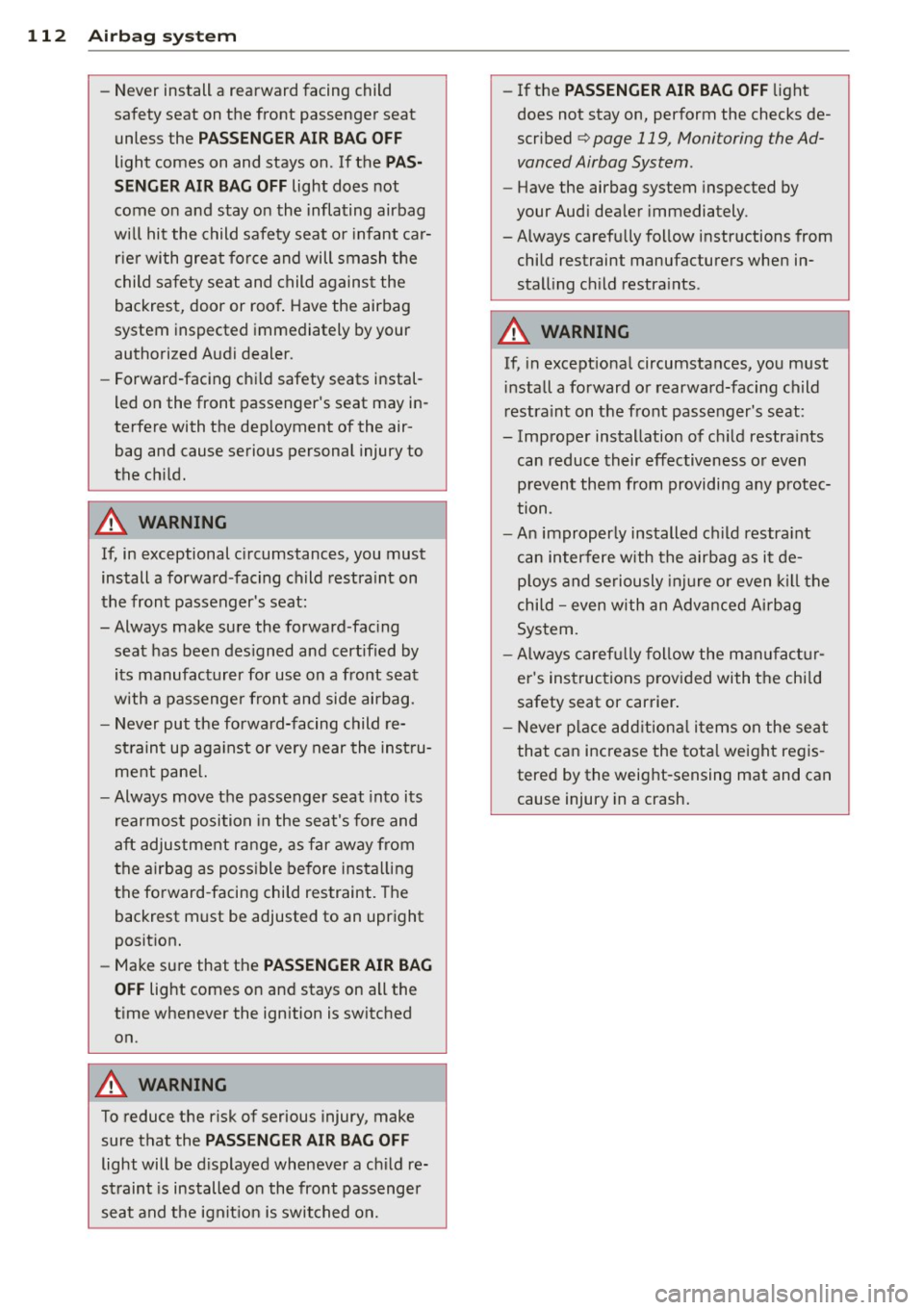
112 Airbag sys te m
- Never install a rearward facing child
safety seat on the front passenger seat
unless the
PA SS EN GER AIR B AG OFF
light comes on and stays on . If the P A S
SE NGER AI R BA G OFF
light does not
come on and stay on the inflating airbag
wi ll hit the child safety seat or infant car
rier with great force and will smash the
child safety seat and child agains t the
backrest, door or roo f. Have the airbag
system inspected immediately by your
authorized Audi dealer .
- Forward-facing chi ld safety seats instal
led on the front passenger's seat may in
terfere with the deployment of the air bag and cause serious personal injury to
the ch ild.
A WARNING
If, in exceptional c ircumstances, you must
install a forward -facing child restra int on
the front passenger's seat:
- Always make sure the forward -fac ing
seat has been des igned and certified by
its manufacturer for use on a front seat
with a passenger front and side airbag.
- Never put the forward-facing child re
straint up aga inst or very near the inst ru
ment pane l.
- Always move the passenger seat into its
rearmost position in the seat's fore and
aft adjustment range , as far away from
the a irbag as poss ible before installing
the fo rward-facing child restraint. The
backrest must be adjusted to an upright
position.
- Make sure that the
PASSENGER AIR BAG
OFF
light comes on and stays on all the
t ime whenever the ignition is switched
on.
A WARNING
To reduce the risk of serious injury, make sure that the
PASSENGER AI R BAG OFF
light will be d isplayed whenever a ch ild re
straint is installed on the front passenger
seat and the ignit ion is switched on. -
If the
PASSENGER AIR BAG OFF light
does not stay on, perform the checks de
scribed
<=> page 119, Monitoring the Ad
vanced Airbag System .
-Have the airbag system inspected by
your Aud i dea ler immediately.
- Always carefully follow instructions from
child restraint manufacturers when in
stall ing ch ild restra ints .
A WARNING
=
If, in except iona l circumstances, you must
i nstall a forward or rearwa rd-facing child
restra int on the front passenger's seat :
- Improper installation of ch ild restra ints
can reduce their effectiveness o r even
p revent them from providing any protec
tion .
- An improp erly installed ch ild restra int
can interfere with the airbag as it de
p loys and seriously inj ure o r even k ill the
child -even with an Advance d Airbag
System.
- Always carefu lly follow the m anu fact ur
er 's ins truc tions p rov ided with the chi ld
safety seat or carrier .
- Never p lace add itiona l it ems on the seat
that can increase the total weight regis
tered by the weight-sensing mat and can
cause injury in a crash.
Page 115 of 244
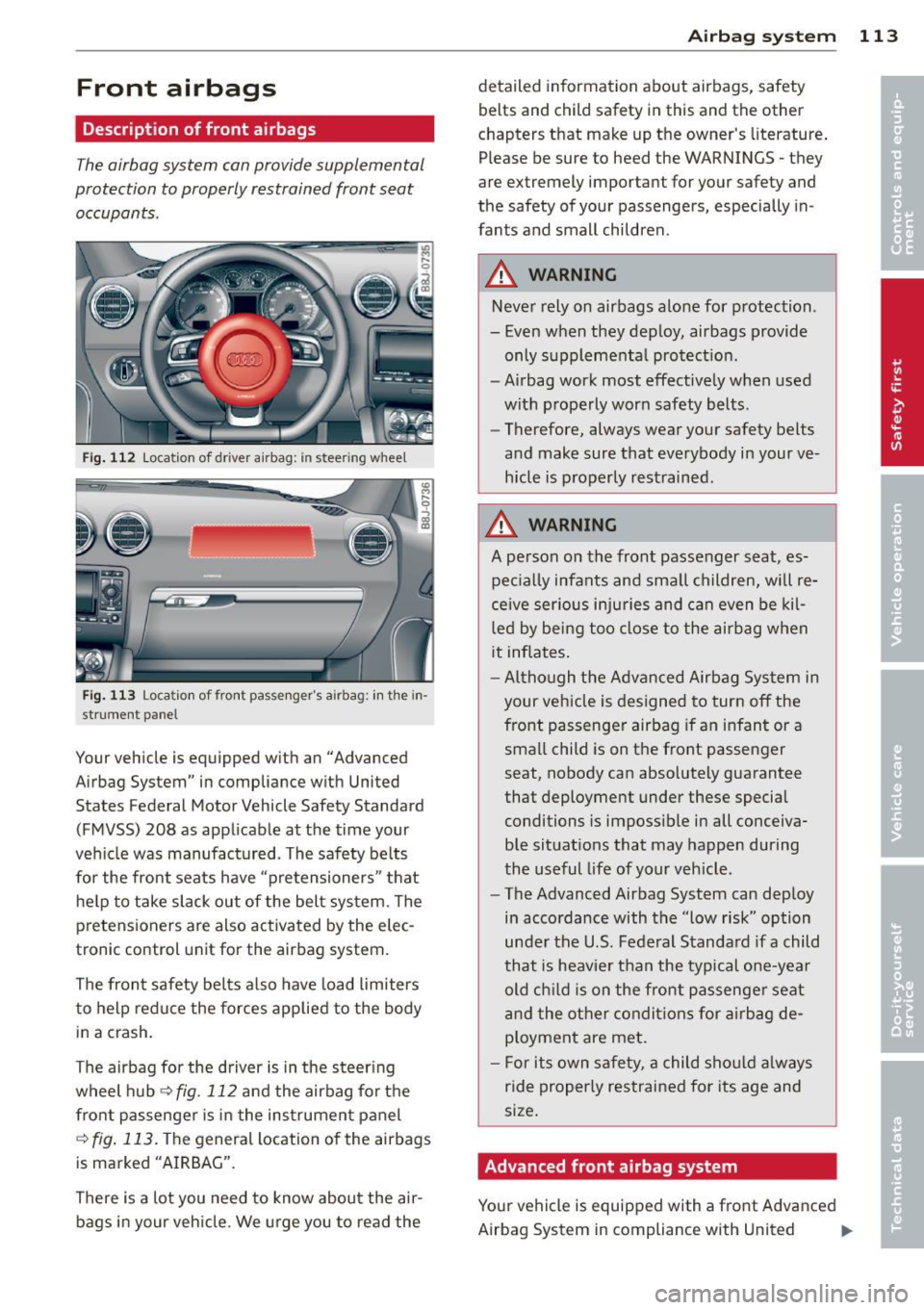
Front airbags
Description of front airbags
The airbag system can provide supplemental
protection to properly restrained front seat
occupants .
Fig. 112 Location of dri ver airbag: in steering whee l
Fig. 113 Location of front passe nger's ai rb ag : in the in
strument panel
Your vehicle is equipped with an "Advanced
Airbag System" in compliance with United
States Federal Motor Vehicle Safety Standard
(FMVSS) 208 as applicable at the time your
vehicle was manufactured . The safety belts
for the front seats have "pretensioners" that
help to take slack out of the belt system. The
pretensioners are also activated by the elec
tronic control unit for the airbag system.
The front safety belts also have load limiters
to help reduce the forces applied to the body
in a crash .
The airbag for the driver is in the steering
wheel hub¢
fig. 112 and the airbag for the
front passenger is in the instrument panel
¢fig. 113. The general location of the airbags
is marked "AIRBAG".
There is a lot you need to know about the air
bags in your vehicle. We urge you to read the
Airbag system 113
detailed information about airbags, safety
belts and child safety in this and the other
chapters that make up the owner's literature .
Please be sure to heed the WARNINGS - they
are extremely important for your safety and
the safety of your passengers, especially in
fants and small children.
A WARNING ,.;;
Never rely on airbags alone for protection .
- Even when they deploy, airbags provide
only supplementa l protection.
- Airbag work most effectively when used
with properly worn safety belts.
- Therefore, always wear your safety belts
and make sure that everybody in your ve
hicle is properly restrained.
A WARNING
A person on the front passenger seat, es
pecially infants and small children, will re
ceive serious injuries and can even be kil
led by being too close to the airbag when
it inflates .
- Although the Advanced Airbag System in
your vehicle is designed to turn off the
front passenger airbag if an infant or a
small child is on the front passenger
seat, nobody can absolutely guarantee
that deployment under these special
conditions is impossible in all conceiva
ble situations that may happen during
the useful life of your vehicle .
- The Advanced Airbag System can deploy
in accordance with the "low risk" option
under the U.S. Federal Standard if a child
that is heavier than the typical one-year
old child is on the front passenger seat
and the other condit ions for airbag de
ployment are met.
- For its own safety, a child should always
ride properly restrained for its age and
size.
Advanced front airbag system
-
Your vehicle is equipped with a front Advanced
Airbag System in compliance with United
Ill>